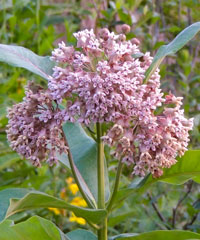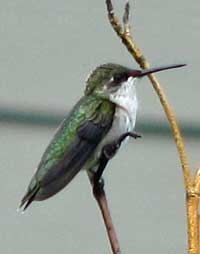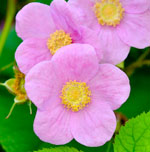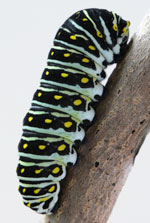 | | Common milkweed |
As most of you know, milkweeds are ESSENTIAL for monarchs. It's the only type of plant the monarch caterpillars can eat. Each kind of butterfly has their own host plant or plants, but for monarchs, milkweeds--the genus Asclepias--is it. Unfortunately, even though the need for additional milkweeds is great, it's difficult to find PESTICIDE-FREE milkweeds. If you find milkweeds somewhere, be sure to inquire about any possible application of systemic pesticides, a common practice especially in chain stores. We have milkweeds to distribute!
The Plantsmen Nursery again has grown pesticide-free, local-ecotype milkweeds for us and we're offering them at our cost, which through the generosity of Plantsmen Nursery, is offering them to us at their cost. All in all, a great deal for us and a great deal for monarchs! We'll have swamp milkweed ( Asclepias incarnata) and common milkweed ( A. syriaca) available THIS WEEK. If you're interested in purchasing 6-packs for $7 each, email me at hg.cny@verizon.net. They'll be available for pick-up this Tuesday evening (May 20) from 5-7 pm, Thursday (May 22) from 4-7 pm, and by appointment. We have a limited supply, so if we run out, we'll distribute plants first to official Wild Ones/HGCNY Members. (See the sidebar for info on how to become a member so you'll have access to perks such as this as well as our Members-only annual field trip.)2014 Shopping Guide
Don't forget to use our Native Plant Shopping Guide when you shop for native plants of any kind. More information is in the story below.
 Janet Allen, President, HGCNY
|
 |
|
Deer resistant NATIVE plants
|
 Many people have problems with deer browse. You can find quite a few lists of deer-resistant plants in books and on the internet, BUT many of these lists include non-native plants and even non-native invasive plants. We've researched the available lists of deer-resistant plants and have selected only the Northeast natives from these lists. We've ended up with quite an extensive list of plants, but we suspect that some of these plants may not be all that deer resistant. We can't come up with a perfect list, of course, since deer will eat anything if they're hungry enough, and what may be deer-resistant in one yard or locality may not be in another due to the surrounding vegetation choices or even preferences in certain deer herds. This is where you come in. We'd like your help to "crowd-source" a list on native deer-resistant plants with HGCNYers as the "crowd." You can download this draft list (a pdf file) and let us know which of these plants are definitely NOT deer-resistant in your experience OR if they are close to being deer-proof. If there seems to be a consensus on certain plants (again knowing that there may be individual situations that are unlike other settings), we'll remove the plants from the list or for the almost-deer-proof plants, put them in bold. IMPORTANT CAVEATA list of deer-resistant native landscaping plants will not solve the problem beyond our yards. The out-of-balance deer population is destroying our forests. As a recent Cornell study noted: "It's obvious that the deer are affecting the above-ground species, but it's like an iceberg. There are major effects below the soil surface. We are seeing a divergence of seeds contained within the soil from what should be there," says DiTommaso. "We are not seeing the seeds of woody plants. Instead, we're seeing an escalation of non-native seed and the virtual elimination of woody plant seeds." ( Read more about this study as described in the Ecological Landscaping Association newsletter.) Communities beyond our yards--city, state, nation--have to have a conversation about solving this larger, very serious problem in a humane, but effective way. |
 |
|
Hummingbirds and native plants
|
 | On a favorite perch on a dead tree
|
From the Audubon website:
* To sustain their supercharged metabolisms, hummingbirds must eat once every 10 to 15 minutes and visit between 1,000 and 2,000 flowers per day. * Research has shown that ecosystems with a high percentage of native plants will produce a higher volume of nectar than exotic plantings, and thus support a greater concentration of insects and spiders available as prey for hummingbirds and other birds. Some recommended natives are: trumpet vine ( Campsis radicans), bee-balm or Oswego tea ( Monarda), trumpet honeysuckle ( Lonicera sempervirens), cardinal flower lobelia ( Lobelia cardinalis) and jewelweed ( Impatiens capensis). See Our Habitat Garden at Some other tips from Audubon:* Leave some sticks and small branches on bushes and trees for perches. * Encourage your neighbors to make their yards hummingbird friendly, too, to create an entire corridor of habitat .
|
 |
The Seneca Nation's native plant policy
|
 The Seneca Nation (in the Allegany Territory near Salamanca, NY) has adopted a policy that new landscaping plantings in public spaces be exclusively indigenous plants. They also are encouraging private landowners to choose indigenous species, too, and to remove invasive and introduced Eurasian plants. In addition to the proven environmental benefits, indigenous plants are an important part of their cultural heritage. Read more on the Seneca Nation website. |
|
2014 Native Plant Shopping Guide
|
Our FREE guide is ready for download!
 What question do we get asked most often? Where can I find native plants. Now you'll know! What question do we get asked most often? Where can I find native plants. Now you'll know!
Our 2014 Guide has the same general format as our previous Guides with a few new codes:
- F indicates Pesticide-Free plants
- BB indicate plants especially good for bumble bees. Both qualities are important.
Click on the photo above or HERE to download the entire Guide as one .pdf file.
OR you can download any or all of the parts separately for printing.
Here are the THREE PARTS of this guide:
If your computer downloads the files, but you don't know where they are, look in your browser settings to find your Downloads folder.
Still having trouble? Contact us and we'll email the .pdf file to you directly.
The Introduction section
Whether or not you print it out, please read the Introduction for Shopping Tips, contact information for the vendors and other helpful information.
We recommend that you CALL AHEAD before you set out on your shopping trip! Confirm the hours the nurseries are open and confirm that your selected plants are currently in stock. What is available in May, for example, may not be available in July. Call ahead to avoid disappointments and wasted gas!
Thank you for patronizing our local native plant nurseries. Supporting these nurseries is an important way to grow the native plant movement.
|
 |
|
Sara Stein: On lawns and meadows
|
 "That gifts were being offered was evident in the general hum and flutter of insect life. The meadow was audible with bees and crickets; the mowed grass was silent. The meadow waved and nodded in the wind; crowds of leaf hoppers leapt to the brush of a hand. The lawn was deadly still." "That gifts were being offered was evident in the general hum and flutter of insect life. The meadow was audible with bees and crickets; the mowed grass was silent. The meadow waved and nodded in the wind; crowds of leaf hoppers leapt to the brush of a hand. The lawn was deadly still."
~ Sara Stein, Noah's Garden: Restoring the Ecology of Our Own Back Yards, 1993, p. 140
|
|
|
|
Contribute to our community AND learn from the experts
|
 | | Clark Reservation |
In 2006, a group of "regular" people, but also of well-known local plant experts created a native plant garden at Clark Reservation to highlight the natives that grow in the park. A few dedicated volunteers have been working to maintain the garden, but they need a few more people to help. What's in it for you? First, knowing you've contributed to this community project. BUT, you'll also learn a lot from working with the native plant experts who are in charge of this project. If you're able to help, please contact Deb Shanahan at debbys@verizon.net.
|
|
Start planning for our HGCNY fall plant sale
|
 | | Flowering raspberry (Rubus odoratus) |
It's not too early to starting thinking of our fall plant sale. As you observe your plantings this spring and summer, note which plants you'd like to donate to our sale. Consider potting them up early so they're established in their pots in time for our sale on Sept. 13. Our plant sale profits fund this newsletter.
|
Habitat Gardening Presentations
|
 | | Black swallowtail caterpillar |
Sat. June 21, 10:00 am:
Creating a Monarch Waystation and a Butterfly-Friendly Landscape
Northern Onondaga Library at Cicero 8686 Knowledge Ln. Cicero.
FREE and open to the public.
|
|
Become a Baltimore Woods Citizen Scientist
Sat. May 24, 9-noon
|
NYS's extensive farming history has left us with vast expanses of abandoned farmland, covering over 50% of the state. Although most of this land has had at least a century to recover, the returning forests are lacking a key ecological and beautiful aspect: their native wildflowers.
The sluggish dispersal rates of these plants have greatly hindered their reestablishment.
Having been farmed into the early 1970s, Baltimore Woods is no exception, and still lacks its natural wildflower cover and diversity.
This is a SUNY-ESF citizen science project intended to restore native wildflowers across NYS, and gather usable scientific data about wildflower reestablishment.
On their own, some species in New York will only spread 30 feet in 70 years. With a little help from the community, think of how far they can get in the next 70 years.
For more info, email
|
 |
 |
Since HGCNY is a chapter of the national organization Wild Ones, when you become a member of Wild Ones, you're automatically a member of HGCNY, too. And since Wild Ones is an official not-for-profit, your membership is tax-deductible.
It's easy to become a member, receive the bimonthly Wild Ones Journal, and support our mission.
|
|
As more of us participate on our Facebook page, this will become a useful resource for asking (and answering!) local HGCNYers' questions about habitat gardening.
|
|
Our Habitat Garden website
|
 Visit Our Habitat Garden website for information on providing habitat, earth-friendly gardening practices, plants, and various creatures here in Central New York. |
Visit Our Edible Garden website to see an example of a local vegetable and fruit garden. An edible garden is a perfect complement to your habitat garden.
|
|
 |
|